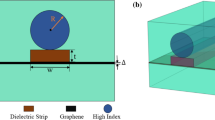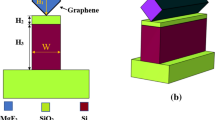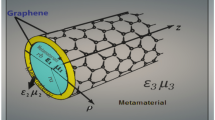Abstract
In this paper, we derive analytical expressions for the spatial evolution of the instantaneous Poynting vector for the transverse magnetic (TM) surface plasmon (SP) modes of a symmetric planar dielectric-metal-dielectric optical waveguide. We discuss the behaviour of the Poynting vector in the metal film due to the optical absorption of electromagnetic waves propagating through the medium to excite the surface plasmons in a resonant manner in the metal film at the interface. This optical absorption of the electromagnetic waves results in a finite propagation length of SP modes. We derive an analytical formula for the penetration depth of the instantaneous Poynting vector in the dielectric cladding regions and show that it is different as compared to the penetration depth of the average Poynting vector. We utilize this analytical formula to calculate the optimum thickness of the affinity layer in a graphene-based surface plasmon resonance (SPR) biosensor and analyze its performance in terms of sensitivity and Figure-of-Merit. We also show that our analytical formula can be used to calculate the optimum thickness of a thin high-index dielectric layer which is added to any conventional SPR based sensor to enhance its sensitivity. The optimum thickness thus calculated correlates closely with the experimental results that have been published previously. The analysis done in this paper can also be utilized in calculating the separation between any two adjacent waveguides/optical films which are coupled together evanescently, such as directional couplers and TE/TM polarisers.










Similar content being viewed by others
Availability of data and material
Available with the corresponding author.
Code availability
Available with the corresponding author.
References
Akimov, Y.A., Koh, W.S., Sian, S.Y., Ren, S.: Nanoparticle-enhanced thin film solar cells: metallic or dielectric nanoparticles? Appl. Phys. Lett. 96, 073111 (2010). https://doi.org/10.1063/1.3315942
Akter, S., Abdur Razzak, S.M.: Highly sensitive open-channels based plasmonic biosensor in visible to near-infrared wavelength. Results Phys. 13, 102328 (2019). https://doi.org/10.1016/j.rinp.2019.102328
Askari, M., Hosseini, M.V.: A novel metamaterial design for achieving a large group index via classical electromagnetically induced reflectance. Opt. Quantum Electron. 52, 1–17 (2020). https://doi.org/10.1007/s11082-020-02302-y
Babar, S., Weaver, J.H.: Optical constants of Cu, Ag, and Au revisited. Appl. Opt. 54, 477–481 (2015). https://doi.org/10.1364/ao.54.000477
Barrera, G., Mocha, W.L., Garcı, A.: On the definition of the Poynting vector: a non-local derivation. Phys. B Condens. Matter 405, 2920–2924 (2010). https://doi.org/10.1016/j.physb.2010.01.004
Bhatia, P., Gupta, B.D.: Surface-plasmon-resonance-based fiber-optic refractive index sensor: sensitivity enhancement. Appl. Opt. 50, 2032–2036 (2011). https://doi.org/10.1364/AO.50.002032
Born, M., Wolf, E.: Principles of Optics: Electromagnetic Theory of Propagation, Interference and Diffraction of Light. Elsevier, Amsterdam (2013)
Bruna, M., Borini, S.: Optical constants of graphene layers in the visible range. Appl. Phys. Lett. 19, 031901 (2009). https://doi.org/10.1063/1.3073717
Burke, J.J., Stegeman, G.I., Tamir, T.: Surface-polariton-like waves guided by thin, lossy metal films. Phys. Rev. B 33, 5186–5201 (1986). https://doi.org/10.1103/PhysRevB.33.5186
Cheng, D.K.: Field and Wave Electromagnetics. Pearson Education India, Noida (1989)
Chen, C.H., Wang, L.: Maximization of extinction ratios of thin-metal-clad optical waveguide polarizers with proper dielectric-cover-layer thickness. Jpn. J. Appl. Phys. 39, 4130–4137 (2000). https://doi.org/10.1143/JJAP.39.4130
Chien, F.C., Chen, S.J.: A sensitivity comparison of optical biosensors based on four different surface plasmon resonance modes. Biosens. Bioelect. 20, 633–642 (2004)
Dai, D., Wang, Z., Julian, N., Bowers, J.E.: Compact broadband polarizer based on shallowly-etched silicon-on-insulator ridge optical waveguides. In: Optics InfoBase Conference Papers (2011)
Dastmalchi, B., Tassin, P., Koschny, T., Soukoulis, C.M.: A new perspective on plasmonics: confinement and propagation length of surface plasmons for different materials and geometries. Adv. Opt. Mater. 4, 177–184 (2016). https://doi.org/10.1002/adom.201500446
Deparis, O.: Poynting vector in transfer-matrix formalism for the calculation of light absorption profile in stratified isotropic optical media. Opt. Lett. 36, 3960–3962 (2011)
Ferreira, J.A.: Application of the Poynting vector for power conditioning and conversion. IEEE Trans. Educ. 31, 257–264 (1988)
Fletcher, M., Loeb, G.I.: Influence of substratum characteristics on the attachment of a marine pseudomonad to solid surfaces. Appl. Environ. Microbiol. 37, 67–72 (1979). https://doi.org/10.1128/aem.37.1.67-72.1979
Ghatak, A.K., Thyagarajan, K.: Optical Electronics. Cambridge University Press, Cambridge (1989)
Grabinski, H., Wiznerowicz, F.: Energy transfer on three-phase high-voltage lines: the strange behavior of the Poynting vector. Electr. Eng. 92, 203–214 (2010). https://doi.org/10.1007/s00202-010-0176-0
Gupta, B.D.: Surface plasmon resonance based fiber optic sensors, Reviews in Plasmonics 2010, pp. 105–137, Springer, New York (2012)
Gupta, B.D., Srivastava, S.K., Verma, R.: Fiber Optic Sensors Based on Plasmonics. World Scientific, Singapore (2015)
Hawthorne, E.I.: Flow of energy in DC machines. Trans. Am. Inst. Electr. Eng. I Commun. Electron. 72, 438–445 (1953)
Hawthorne, E.I.: Flow of energy in synchronous machines. Trans. Am. Inst. Electr. Eng. I Commun. Electron. 73, 1–10 (1954)
Homola, J.: Electromagnetic theory of surface plasmons, Springer series on chemical sensors and biosensors, vol. 4, pp. 3–44, Springer, Heidelberg (2006). https://doi.org/10.1007/5346_013
Hosono, T.: Electromagnetic power flow and its expression—poynting vector and Nukiyama vector. Electron. Commun. Jpn. II Electron. 78, 20–32 (1995)
Hutter, E., Fendler, J.H.: Exploitation of localized surface plasmon resonance. Adv. Mater. 16, 1685–1706 (2004). https://doi.org/10.1002/adma.200400271
Kaminow, I.P., Mammel, W.L., Weber, H.P.: Metal-clad optical waveguides: analytical and experimental study. Appl. Opt. 13, 396–405 (1974)
Ko, H.C., Chuang, C.W.: On the energy flux and Poynting vector in a moving dispersive dielectric. Radio Sci. 12, 337–340 (1977)
Kullab, H.M., Taya, S.A., El-Agez, T.M.: Metal-clad waveguide sensor using a left-handed material as a core layer. J. Opt. Soc. Am. B 29, 959–964 (2012). https://doi.org/10.1364/josab.29.000959
Kushwah, H., Anand, J.K.: Behaviour of poynting vector for guided modes of dielectric optical waveguides and its usefulness in the design of evanescently coupled optical devices. In: Photonics and Electromagnetics Research Symposium-Fall, PIERS-Fall 2019-Proceedings (2019)
Lahav, A., Auslender, M., Abdulhalim, I.: Sensitivity enhancement of guided-wave surface-plasmon resonance sensors. Opt. Lett. 33, 2539–2541 (2008). https://doi.org/10.1364/ol.33.002539
Lavers, C.R., Itoh, K., Wu, S.C., et al.: Planar optical waveguides for sensing applications. Sens. Actuators B Chem. 69, 85–95 (2000). https://doi.org/10.1016/S0925-4005(00)00412-3
Lin, C.-I., Gaylord, T.K.: Characterization of the loss of plasmonic modes in planar metal-insulator-metal waveguides by a coupling-simulation approach. Appl. Opt. 49, 936–944 (2010)
Liu, N., Weiss, T., Mesch, M., et al.: Planar metamaterial analogue of electromagnetically induced transparency for plasmonic sensing. Nano Lett. 10, 1103–1107 (2010). https://doi.org/10.1021/nl902621d
Lytle, R.J., Lager, D.L., Miller, E.K.: Poynting vector behaviour in lossy media and near a half space. Radio Science 11(11), 875–883 (1976)
Maier, S.A.: Plasmonics: Fundamentals and Applications. Springer, Berlin (2007)
Malitson, I.H.: Interspecimen comparison of the refractive index of fused silica. J. Opt. Soc. Am. 55, 1205–1209 (1965). https://doi.org/10.1364/josa.55.001205
Markel, V.A.: Correct definition of the Poynting vector in electrically and magnetically polarizable medium reveals that negative refraction is impossible. Opt. Express 16, 19152–19168 (2008)
Morris, N.A., Styer, D.F.: Visualizing Poynting vector energy flow in electric circuits. Am. J. Phys. 80, 552–554 (2012)
Myung, S., Solanki, A., Kim, C., et al.: Graphene-encapsulated nanoparticle-based biosensor for the selective detection of cancer biomarkers. Adv. Mater. 23, 2221–2225 (2011). https://doi.org/10.1002/adma.201100014
Nemova, G., Kashyap, R.: Theoretical model of a planar integrated refractive index sensor based on surface plasmon-polariton excitation. Opt. Commun. 275, 76–82 (2007)
Otto, A., Sohler, W.: Modification of the total reflection modes in a dielectric film by one metal boundary. Opt. Commun. 3, 254–258 (1971). https://doi.org/10.1016/0030-4018(71)90017-4
Palik, E.D.: Handbook of Optical Constants of Solids. Elsevier, Amsterdam (2012)
Piliarik, M., Vaisocherová, H., Homola, J.: Surface plasmon resonance biosensing. Methods Mol. Biol. 503, 65–88 (2009)
Poynting, J.H.: XV. On the transfer of energy in the electromagnetic field. Philos. Trans. R. Soc. Lond. 174, 343–361 (1884)
Prade, B., Vinet, J.Y., Mysyrowicz, A.: Guided optical waves in planar heterostructures with negative dielectric constant. Phys. Rev. B 44, 13556–13572 (1991)
Prajapati, Y.K., Yadav, A., Verma, A., et al.: Effect of metamaterial layer on optical surface plasmon resonance sensor. Optik (Stuttg) 124, 3607–3610 (2013). https://doi.org/10.1016/j.ijleo.2012.12.021
Rashed, A.R., Gudulluoglu, B., Yun, H.W., et al.: Highly-sensitive refractive index sensing by near-infrared metatronic nanocircuits. Sci. Rep. 8, 1–9 (2018). https://doi.org/10.1038/s41598-018-29623-z
Sadiku, M.N.O.: Elements of Electromagnetics. Oxford University Press, Oxford (2007)
Scottt, J.C.W.: The Poynting vector in the ionosphere. Proc. IRE 38, 1057–1068 (1950)
Sharma, A.K., Jha, R., Gupta, B.D.: Fiber-optic sensors based on surface plasmon resonance: a comprehensive review. IEEE Sens. J. 7, 1118–1129 (2007)
Sharma, V.K., Kumar, A., Kapoor, A.: High extinction ratio metal-insulator-semiconductor waveguide surface plasmon polariton polarizer. Opt. Commun. 284, 1815–1821 (2011). https://doi.org/10.1016/j.optcom.2010.11.079
Sharma, V.K., Madaan, D., Kapoor, A.: High extinction ratio and short length surface plasmon polariton polarizer. IEEE Photonics Technol. Lett. 28, 1541–1544 (2016). https://doi.org/10.1109/LPT.2016.2557848
Sherry, L.J., Jin, R., Mirkin, C.A., et al.: Localized surface plasmon resonance spectroscopy of single silver triangular nanoprisms. Nano Lett. 6, 2060–2065 (2006). https://doi.org/10.1021/nl061286u
Singh, S., Mishra, S.K., Gupta, B.D.: Sensitivity enhancement of a surface plasmon resonance based fibre optic refractive index sensor utilizing an additional layer of oxides. Sens. Actuators A Phys. 193, 136–140 (2013). https://doi.org/10.1016/j.sna.2013.01.012
Slepian, J.: Energy and energy flow in the electromagnetic field. J. Appl. Phys. 13, 512–518 (1942)
Szunerits, S., Maalouli, N., Wijaya, E., et al.: Recent advances in the development of graphene-based surface plasmon resonance (SPR) interfaces. Anal. Bioanal. Chem. 405, 1435–1443 (2013). https://doi.org/10.1007/s00216-012-6624-0
Tabassum, R., Gupta, B.D.: SPR based fiber-optic sensor with enhanced electric field intensity and figure of merit using different single and bimetallic configurations. Opt. Commun. 367, 23–34 (2016). https://doi.org/10.1016/j.optcom.2016.01.014
Tabassum, R., Gupta, B.D.: Performance analysis of bimetallic layer with zinc oxide for SPR-based fiber optic sensor. J. Light Technol. 33, 4565–4571 (2015). https://doi.org/10.1109/JLT.2015.2479631
Tabassum, R., Gupta, B.D.: Simultaneous tuning of electric field intensity and structural properties of ZnO: graphene nanostructures for FOSPR based nicotine sensor. Biosens. Bioelectron. 91, 762–769 (2017). https://doi.org/10.1016/j.bios.2017.01.050
Taya, S.A., Shabat, M.M.: Sensitivity enhancement in optical waveguide sensors using metamaterials. Appl. Phys. A Mater. Sci. Process. 103, 611–614 (2011). https://doi.org/10.1007/s00339-011-6406-0
Tripathi, S.M., Bock, W.J., Mikulic, P., et al.: Long period grating based biosensor for the detection of Escherichia coli bacteria. Biosens. Bioelectron. 35, 308–312 (2012). https://doi.org/10.1016/j.bios.2012.03.006
Verma, R., Gupta, B.D., Jha, R.: Sensitivity enhancement of a surface plasmon resonance based biomolecules sensor using graphene and silicon layers. Sens. Actuators B Chem. 160, 623–631 (2011). https://doi.org/10.1016/j.snb.2011.08.039
Verma, A., Prakash, A., Tripathi, R.: Performance analysis of graphene based surface plasmon resonance biosensors for detection of pseudomonas-like bacteria. Opt. Quantum Electron. 47, 1197–1205 (2015). https://doi.org/10.1007/s11082-014-9976-1
Wu, L., Chu, H.S., Koh, W.S., Li, E.P.: Highly sensitive graphene biosensors based on surface plasmon resonance. Opt. Express 18, 14395–14400 (2010). https://doi.org/10.1364/oe.18.014395
Yang, H., Li, J., Xiao, G.: Significantly increased surface plasmon polariton mode excitation using a multilayer insulation structure in a metal–insulator–metal plasmonic waveguide. Appl. Opt. 53, 3642–3646 (2014). https://doi.org/10.1364/ao.53.003642
Funding
This research did not receive any specific grant from funding agencies in the public, commercial, or not-for-profit sectors.
Author information
Authors and Affiliations
Contributions
JKA contributed to the original idea, supervised the study, and contributed to language improvement. HK developed the software using MATLAB for simulation and data analysis; prepared the manuscript and generated the figures.
Corresponding author
Ethics declarations
Conflict of interest
The authors declare no competing interests.
Additional information
Publisher's Note
Springer Nature remains neutral with regard to jurisdictional claims in published maps and institutional affiliations.
Rights and permissions
About this article
Cite this article
Anand, J.K., Kushwah, H. Behaviour of Poynting vector for dielectric-metal-dielectric optical waveguides and applications. Opt Quant Electron 52, 410 (2020). https://doi.org/10.1007/s11082-020-02519-x
Received:
Accepted:
Published:
DOI: https://doi.org/10.1007/s11082-020-02519-x




